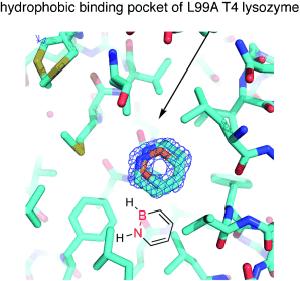|
Related Topics: |
|
|
|
Current News |
|
Chemistry A to Z |
|
About Internetchemistry |
Boron-based compounds trick a biomedical protein |
|
Chemists and biologists have successfully demonstrated that specially synthesized boron compounds are readily accepted in biologically active enzymes, a move that, they say, is a proof of concept that could lead to new drug design strategies. In June 2008, University of Oregon chemist Shih-Yuan Liu reported in the Journal of the American Chemical Society [2, 3] his lab's synthesis of boron-nitrogen compounds with electronic and structural similarities to fundamentally important benzene molecules. That synthesis suggested a new tool for possible use in biomedical research as well as in materials science. |
|
What Liu's lab created were benzene surrogates known as 1,2-dihydro-1,2-azaborines that possess electron-delocalized structures consistent with aromaticity -- a core concept in chemistry where rings of atoms exhibit unexpected stability. Now, in the Sept. 1, 2009, issue of Angewandte Chemie [1], a weekly journal of the German Chemical Society, Liu and colleagues show that their synthesized compounds indeed are accepted in non-polarized hydrophobic pockets of a well-studied enzyme, a member of the lysozyme family discovered by Alexander Fleming in 1921 and used widely in biomedical research. The "proof of concept" was completed in the Institute of Molecular Biology lab of the UO physicist Brian W. Matthews, where Liu's synthesized compound was treated with T4 lysozymes, crystallized and examined with high-resolution X-ray crystallography. "I feel this is a fairly big step forward," Liu said. "Our compounds bind efficiently to the T4 lysozyme and behave as hydrophobic arene molecules similar to natural systems. Our compound actually has polar features, so it was questionable that it would bind to the enzyme's hydrophobic pocket, but it did and very similarly to the way carbon molecules would bind." In essence, Liu and colleagues have potentially put boron, a commonly occurring essential nutrient in plants - but seemingly "bypassed by nature in evolution" of other living things, Liu said - into play as an alternative to carbon in manufacturing target-specific pharmaceuticals. The use of boron in the biomedical field is not new but its acceptance has been hampered by instability, but interest has risen in the last decade, Liu said. An analysis of boron's medical potential appeared in the February issue of EMBO Reports. Boron is being studied by a number of drug manufacturers. It currently is used as an antibacterial drug component and as part of a therapy for multiple myeloma. The advance by Liu's lab strengthens the case that boron-based molecules can be used as new pharmacophores, or as markers of drugs in living tissue, and to improve long-stymied attempts to develop boron-neutron capture therapies to produce inhibiting agents for cancer treatment. "This research provides the first experimental evidence that enzymes in our bodies cannot distinguish between our artificial compound versus the all-carbon systems," Liu said. "We can trick the enzymes to believing they are accepting the real thing." The National Institutes of Health funded the research. Co-authors were Liu's chemistry doctoral student Adam J.V. Marwitz, Matthews and Lijun Liu, a research associate in the Matthews lab. |
|
|
|

